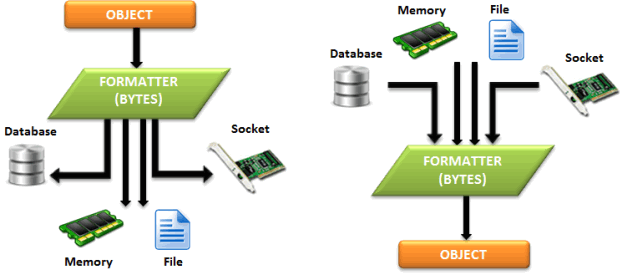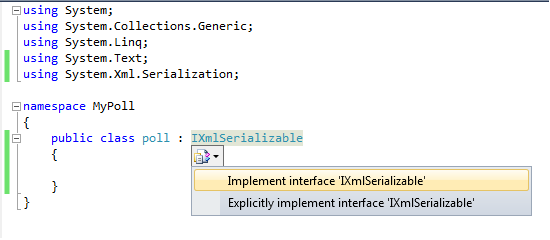What Is The Use Of Serialization In C
A practical guide to C++ serialization. Code. Project. In a nutshell, serialization consists of writing data and objects on a support (a file, a buffer, a socket), so that they can be reconstructed later in the memory of the same or another computing host. The reconstruction process is also known as deserialization.

In this article you will learn about serialization and deserialization In C#.
Serializing a primitive type like a bool, int, or float, is trivial: just write the data as it is (assuming that no compression is used). Serializing a pointer is different: the object it points to must be serialized first. That way deserializing the pointer simply consists of setting its value to the memory address at which the object has been reconstructed. We can distinguish three levels of complexity in serialization, depending on how complex the pointer (and reference) graph is: The pointer graph is a forest (i. Data can simply be serialized bottom up with a depth first traversal of the trees. The pointer graph is a directed acyclic graph (DAG), i.
- Have you ever seen what is inside a serialized object? I will explain to you what is java serialization, then provide you with a sample for serialization.
- Constants const ( // A generic XML header suitable for use with the output of Marshal.
We can still serialize the data bottom up, making sure we write and restore shared data only once. The pointer graph is a general graph, i. We need to write and restore data with forward references so that loops are handled properly. Pointer graph as a tree, a DAG, and with loops. It is always an option to serialize objects using your own customized code. However serialization is much more complex than a simple pretty- print method.
Serialization 1903-1960 Serialization 1903-1960 mandolin model and pricing information.
One would like serialization to support the following features: Serialization should be able to handle any pointer graph (i. Serializing a pointer or a reference should automatically trigger the serialization of the referred object.
Serializing an entire data model can require a lot of code –from simple scalar fields (bool, int, float), to containers (vector, list, hash table, etc), to intricate data structures (graph, quad- tree, sparse matrices, etc). One would like templates that carry most of the burden. The save and load functions must always be in sync: if the . One would like that process to be automated as much as possible. One should have a way of serializing objects without changing their . The reason is that in many case one does not want (or one cannot) change the source files of existing libraries. Serialization needs to support versioning.
As objects evolve, data members are added or removed, and it is desirable to be back compatible –meaning, one can still deserialize archives from older versions into the most recent data model. Serialization should be cross- platform compatible (3. Windows, Linux, Solaris, etc). The boost library provides a serialization that meets all the requirements above, and more: It is extremely efficient, it supports versioning, and it automatically serializes STL containers. Serialization (the save function) and deserialization (the load function) are expressed with one single template, which reduces the size of the code, and resolves the synchronization problem. With a little bit of help, boost serialization is also 3.
Also boost serialization (respectively deserialization) takes an output (respectively input) argument that is very similar to a std: :ostream (respectively std: :istream), meaning that it can be a file on a disk, a buffer, or a socket. You can literally serialize your data over a network. The best way to understand how to serialize with boost is to walk through increasingly complex serialization scenarios.
Basic serialization. The code for serialization, as well as an example that saves and restores simple objects, is given below.
This is achieved because the operator . Note the friend declaration to allow the save/load template to access the private data members of the objects. Also note that serialization expects the object to have a default constructor (which can be private). We create an output archive (here, a file on a disk), and write three instances of class Obj, as well as a pointer to one of the instances. We then read them back and make sure we restore the data as they were.
Note how the restored pointer restored. So we do not need to explicitly serialize pointed objects as boost serialization will make sure the appropriate objects reached in the pointers graph are serialized. For instance, the code below shows that serializing the pointer p. When restoring the pointer restored.
This will trigger serialization. This means that one should not attempt to deserialize an object after a pointer to this object has been deserialized. The reason is that once the pointer deserialization has forced the object deserialization, one cannot rebuild this object at a different address. Frame Photo Editor 5 0 1 Exe. This is typical when versioning is involved.
Note the use of the macro BOOST. Thus we need to explicitly serialized C- string. The class below is a simple helper to serialize C- strings (note that this can be optimized by avoiding the construction of the sdt: :string). A non- intrusive serialization, outside of the class, might be preferable. For instance we would like to serialize a class from a library without altering the library’s hpp file. This is easy when the data members are public.
Obj . This requires a forward declaration of the template. For the sake of simplicity, we give the version for public data members. Instead of saving/loading a vector with the following code.
Archive>. void save(Archive& ar, const std: :vector< Obj> & objs, const unsigned version) . For instance, if a new data member . Thus const data members must be const.
For example. #include < boost/archive/text. There are other archive types available in boost/archive/*.
Text archive that defines boost: :archive: :text. For instance a long is usually 4 bytes on a 3.
In practice though it is pretty portable –there is a non- official version for a portable binary archive. Tags: C++, software.
PHP: serialize - Manual. Warning: on 6. 4 bits machines, if you use a long string only composed of numbers as a key in an array and serialize/unserialize it, you can run into problems: an example code: $arr. But compiled on AMD 6.
Red Hat Taroon), the problem is present. Hope this will help some of you to not loose almost a whole day of debugging ; -).
